The Role of Statistical Data in Criminal Justice Policy Analysis
VerifiedAdded on 2022/09/26
|5
|1069
|18
Report
AI Summary
This report examines the critical role of statistical data in supporting criminal justice policy. It discusses the use of crime reports and surveys to provide varied information about crime characteristics, including incidents, offender details, and trends over time. The analysis highlights the legislative uses of statistical data, such as informing the development and enforcement of legislation. The report references various studies that critique and support the use of statistical data, including its limitations in manipulation and delayed findings, as well as its benefits in cost-benefit modeling and forecasting crime levels. The report also covers how statistical data aids in understanding crime incidence, offender characteristics, and the efficacy of the criminal justice system. It concludes with the importance of comprehensive and timely data analysis to aid in reforming offenders and improving societal outcomes. The report references multiple sources including Aos, Banks, Eterno, Goldberger, Rosenfeld and Weisburd.
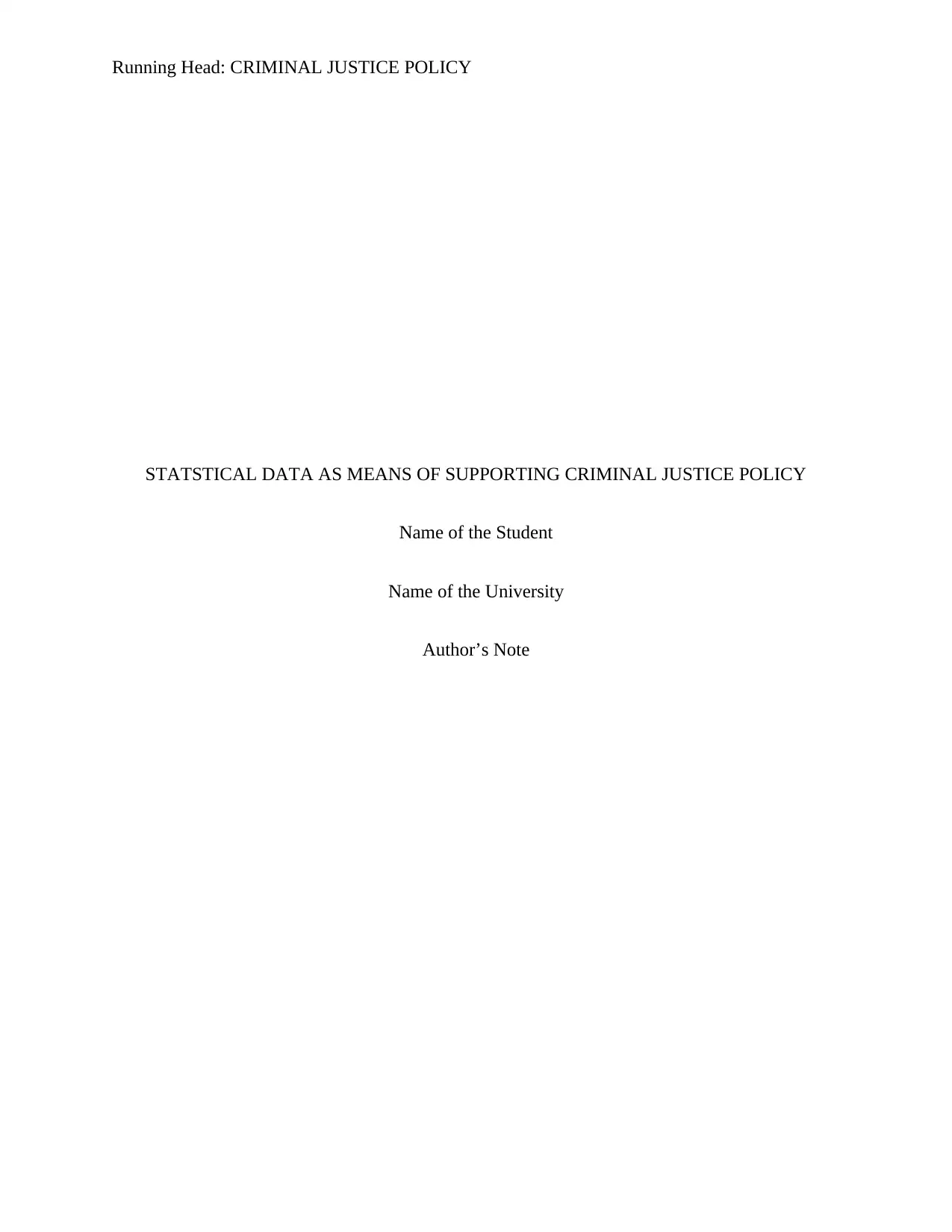
Running Head: CRIMINAL JUSTICE POLICY
STATSTICAL DATA AS MEANS OF SUPPORTING CRIMINAL JUSTICE POLICY
Name of the Student
Name of the University
Author’s Note
STATSTICAL DATA AS MEANS OF SUPPORTING CRIMINAL JUSTICE POLICY
Name of the Student
Name of the University
Author’s Note
Paraphrase This Document
Need a fresh take? Get an instant paraphrase of this document with our AI Paraphraser
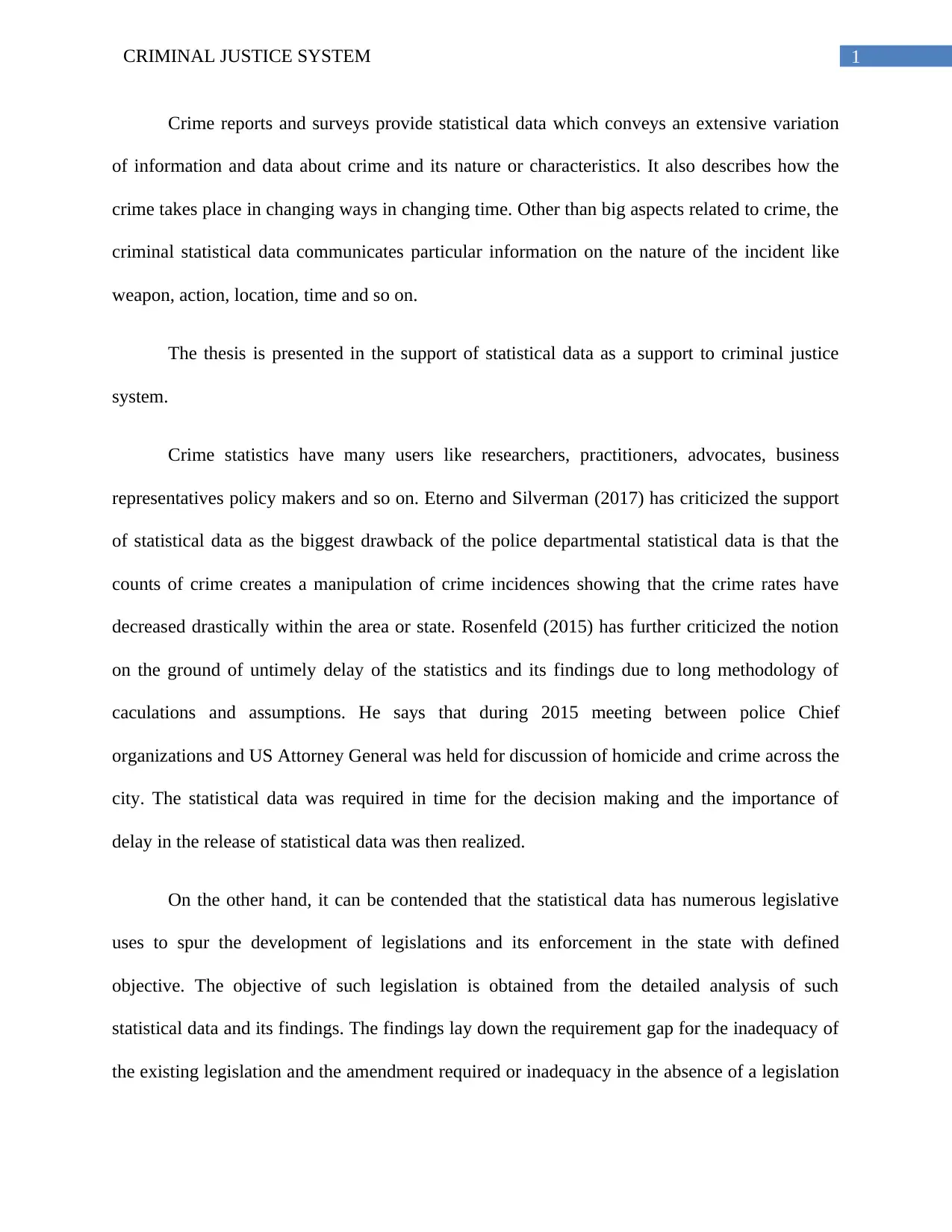
1CRIMINAL JUSTICE SYSTEM
Crime reports and surveys provide statistical data which conveys an extensive variation
of information and data about crime and its nature or characteristics. It also describes how the
crime takes place in changing ways in changing time. Other than big aspects related to crime, the
criminal statistical data communicates particular information on the nature of the incident like
weapon, action, location, time and so on.
The thesis is presented in the support of statistical data as a support to criminal justice
system.
Crime statistics have many users like researchers, practitioners, advocates, business
representatives policy makers and so on. Eterno and Silverman (2017) has criticized the support
of statistical data as the biggest drawback of the police departmental statistical data is that the
counts of crime creates a manipulation of crime incidences showing that the crime rates have
decreased drastically within the area or state. Rosenfeld (2015) has further criticized the notion
on the ground of untimely delay of the statistics and its findings due to long methodology of
caculations and assumptions. He says that during 2015 meeting between police Chief
organizations and US Attorney General was held for discussion of homicide and crime across the
city. The statistical data was required in time for the decision making and the importance of
delay in the release of statistical data was then realized.
On the other hand, it can be contended that the statistical data has numerous legislative
uses to spur the development of legislations and its enforcement in the state with defined
objective. The objective of such legislation is obtained from the detailed analysis of such
statistical data and its findings. The findings lay down the requirement gap for the inadequacy of
the existing legislation and the amendment required or inadequacy in the absence of a legislation
Crime reports and surveys provide statistical data which conveys an extensive variation
of information and data about crime and its nature or characteristics. It also describes how the
crime takes place in changing ways in changing time. Other than big aspects related to crime, the
criminal statistical data communicates particular information on the nature of the incident like
weapon, action, location, time and so on.
The thesis is presented in the support of statistical data as a support to criminal justice
system.
Crime statistics have many users like researchers, practitioners, advocates, business
representatives policy makers and so on. Eterno and Silverman (2017) has criticized the support
of statistical data as the biggest drawback of the police departmental statistical data is that the
counts of crime creates a manipulation of crime incidences showing that the crime rates have
decreased drastically within the area or state. Rosenfeld (2015) has further criticized the notion
on the ground of untimely delay of the statistics and its findings due to long methodology of
caculations and assumptions. He says that during 2015 meeting between police Chief
organizations and US Attorney General was held for discussion of homicide and crime across the
city. The statistical data was required in time for the decision making and the importance of
delay in the release of statistical data was then realized.
On the other hand, it can be contended that the statistical data has numerous legislative
uses to spur the development of legislations and its enforcement in the state with defined
objective. The objective of such legislation is obtained from the detailed analysis of such
statistical data and its findings. The findings lay down the requirement gap for the inadequacy of
the existing legislation and the amendment required or inadequacy in the absence of a legislation
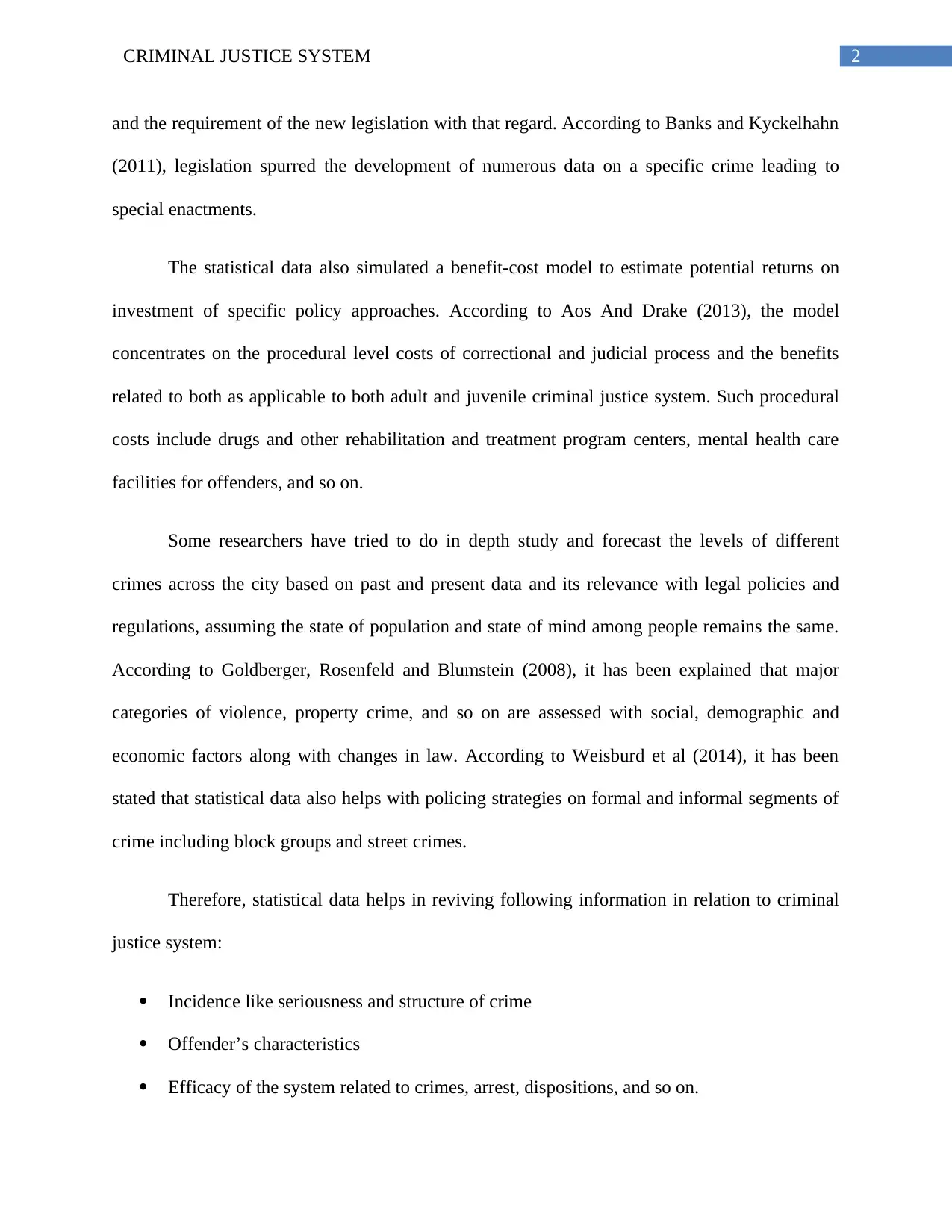
2CRIMINAL JUSTICE SYSTEM
and the requirement of the new legislation with that regard. According to Banks and Kyckelhahn
(2011), legislation spurred the development of numerous data on a specific crime leading to
special enactments.
The statistical data also simulated a benefit-cost model to estimate potential returns on
investment of specific policy approaches. According to Aos And Drake (2013), the model
concentrates on the procedural level costs of correctional and judicial process and the benefits
related to both as applicable to both adult and juvenile criminal justice system. Such procedural
costs include drugs and other rehabilitation and treatment program centers, mental health care
facilities for offenders, and so on.
Some researchers have tried to do in depth study and forecast the levels of different
crimes across the city based on past and present data and its relevance with legal policies and
regulations, assuming the state of population and state of mind among people remains the same.
According to Goldberger, Rosenfeld and Blumstein (2008), it has been explained that major
categories of violence, property crime, and so on are assessed with social, demographic and
economic factors along with changes in law. According to Weisburd et al (2014), it has been
stated that statistical data also helps with policing strategies on formal and informal segments of
crime including block groups and street crimes.
Therefore, statistical data helps in reviving following information in relation to criminal
justice system:
Incidence like seriousness and structure of crime
Offender’s characteristics
Efficacy of the system related to crimes, arrest, dispositions, and so on.
and the requirement of the new legislation with that regard. According to Banks and Kyckelhahn
(2011), legislation spurred the development of numerous data on a specific crime leading to
special enactments.
The statistical data also simulated a benefit-cost model to estimate potential returns on
investment of specific policy approaches. According to Aos And Drake (2013), the model
concentrates on the procedural level costs of correctional and judicial process and the benefits
related to both as applicable to both adult and juvenile criminal justice system. Such procedural
costs include drugs and other rehabilitation and treatment program centers, mental health care
facilities for offenders, and so on.
Some researchers have tried to do in depth study and forecast the levels of different
crimes across the city based on past and present data and its relevance with legal policies and
regulations, assuming the state of population and state of mind among people remains the same.
According to Goldberger, Rosenfeld and Blumstein (2008), it has been explained that major
categories of violence, property crime, and so on are assessed with social, demographic and
economic factors along with changes in law. According to Weisburd et al (2014), it has been
stated that statistical data also helps with policing strategies on formal and informal segments of
crime including block groups and street crimes.
Therefore, statistical data helps in reviving following information in relation to criminal
justice system:
Incidence like seriousness and structure of crime
Offender’s characteristics
Efficacy of the system related to crimes, arrest, dispositions, and so on.
⊘ This is a preview!⊘
Do you want full access?
Subscribe today to unlock all pages.

Trusted by 1+ million students worldwide
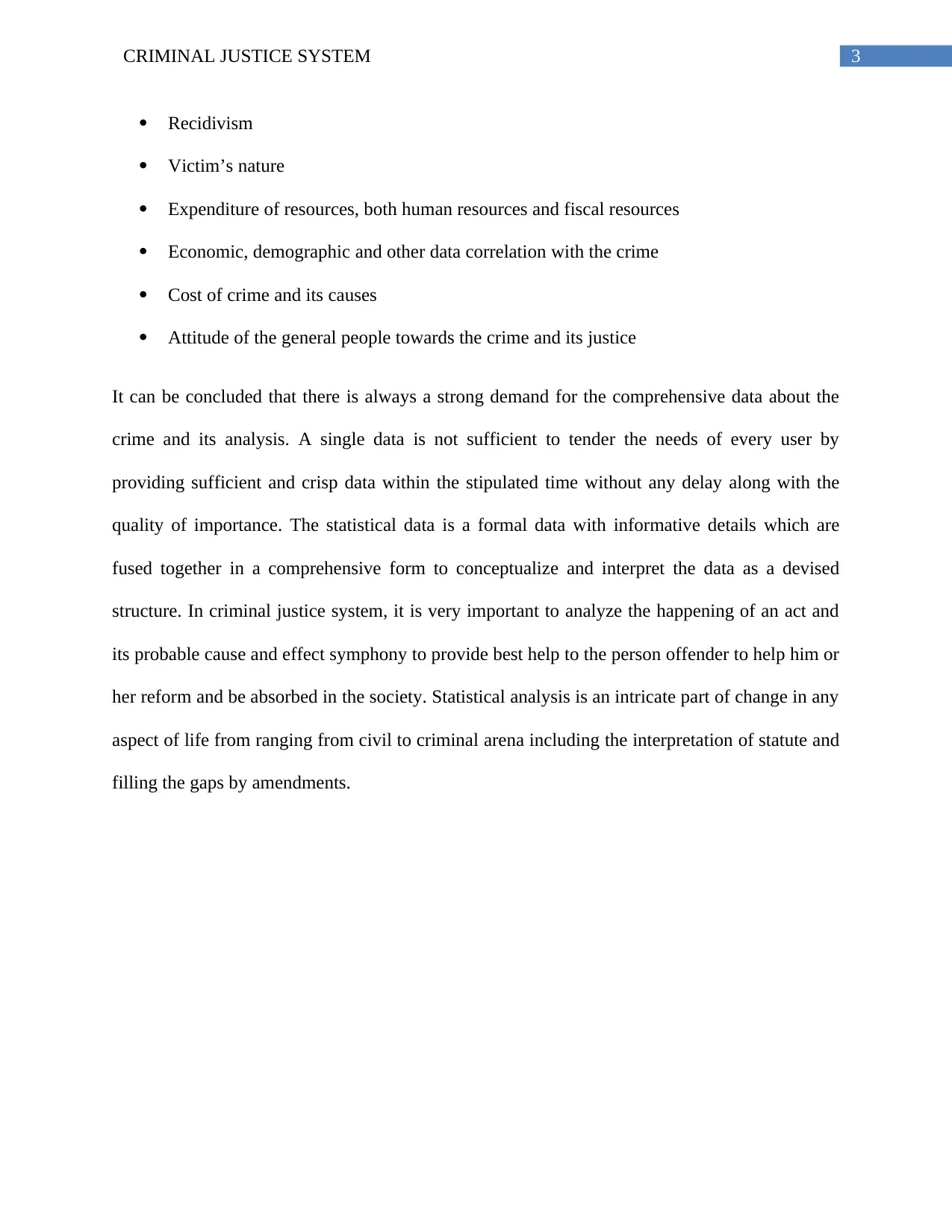
3CRIMINAL JUSTICE SYSTEM
Recidivism
Victim’s nature
Expenditure of resources, both human resources and fiscal resources
Economic, demographic and other data correlation with the crime
Cost of crime and its causes
Attitude of the general people towards the crime and its justice
It can be concluded that there is always a strong demand for the comprehensive data about the
crime and its analysis. A single data is not sufficient to tender the needs of every user by
providing sufficient and crisp data within the stipulated time without any delay along with the
quality of importance. The statistical data is a formal data with informative details which are
fused together in a comprehensive form to conceptualize and interpret the data as a devised
structure. In criminal justice system, it is very important to analyze the happening of an act and
its probable cause and effect symphony to provide best help to the person offender to help him or
her reform and be absorbed in the society. Statistical analysis is an intricate part of change in any
aspect of life from ranging from civil to criminal arena including the interpretation of statute and
filling the gaps by amendments.
Recidivism
Victim’s nature
Expenditure of resources, both human resources and fiscal resources
Economic, demographic and other data correlation with the crime
Cost of crime and its causes
Attitude of the general people towards the crime and its justice
It can be concluded that there is always a strong demand for the comprehensive data about the
crime and its analysis. A single data is not sufficient to tender the needs of every user by
providing sufficient and crisp data within the stipulated time without any delay along with the
quality of importance. The statistical data is a formal data with informative details which are
fused together in a comprehensive form to conceptualize and interpret the data as a devised
structure. In criminal justice system, it is very important to analyze the happening of an act and
its probable cause and effect symphony to provide best help to the person offender to help him or
her reform and be absorbed in the society. Statistical analysis is an intricate part of change in any
aspect of life from ranging from civil to criminal arena including the interpretation of statute and
filling the gaps by amendments.
Paraphrase This Document
Need a fresh take? Get an instant paraphrase of this document with our AI Paraphraser
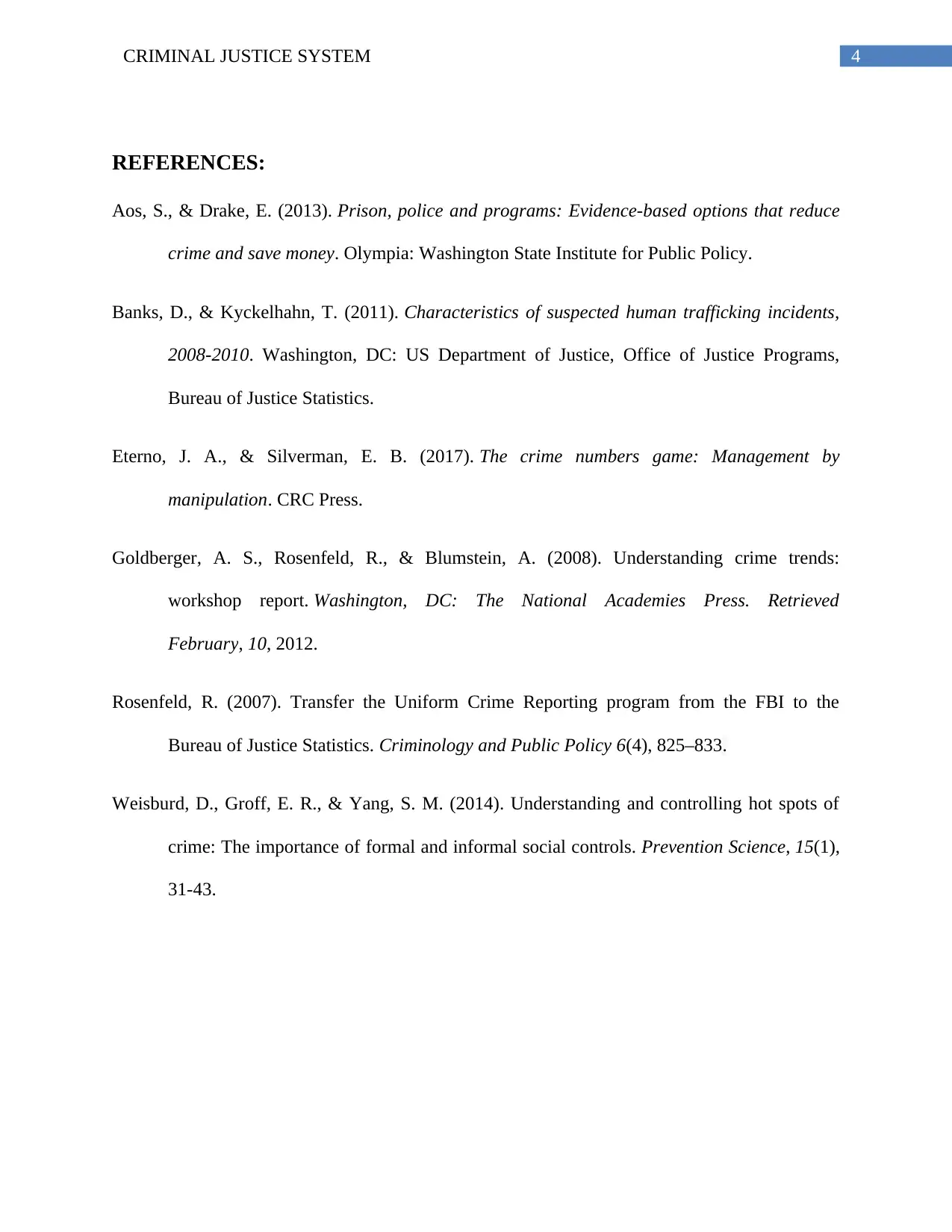
4CRIMINAL JUSTICE SYSTEM
REFERENCES:
Aos, S., & Drake, E. (2013). Prison, police and programs: Evidence-based options that reduce
crime and save money. Olympia: Washington State Institute for Public Policy.
Banks, D., & Kyckelhahn, T. (2011). Characteristics of suspected human trafficking incidents,
2008-2010. Washington, DC: US Department of Justice, Office of Justice Programs,
Bureau of Justice Statistics.
Eterno, J. A., & Silverman, E. B. (2017). The crime numbers game: Management by
manipulation. CRC Press.
Goldberger, A. S., Rosenfeld, R., & Blumstein, A. (2008). Understanding crime trends:
workshop report. Washington, DC: The National Academies Press. Retrieved
February, 10, 2012.
Rosenfeld, R. (2007). Transfer the Uniform Crime Reporting program from the FBI to the
Bureau of Justice Statistics. Criminology and Public Policy 6(4), 825–833.
Weisburd, D., Groff, E. R., & Yang, S. M. (2014). Understanding and controlling hot spots of
crime: The importance of formal and informal social controls. Prevention Science, 15(1),
31-43.
REFERENCES:
Aos, S., & Drake, E. (2013). Prison, police and programs: Evidence-based options that reduce
crime and save money. Olympia: Washington State Institute for Public Policy.
Banks, D., & Kyckelhahn, T. (2011). Characteristics of suspected human trafficking incidents,
2008-2010. Washington, DC: US Department of Justice, Office of Justice Programs,
Bureau of Justice Statistics.
Eterno, J. A., & Silverman, E. B. (2017). The crime numbers game: Management by
manipulation. CRC Press.
Goldberger, A. S., Rosenfeld, R., & Blumstein, A. (2008). Understanding crime trends:
workshop report. Washington, DC: The National Academies Press. Retrieved
February, 10, 2012.
Rosenfeld, R. (2007). Transfer the Uniform Crime Reporting program from the FBI to the
Bureau of Justice Statistics. Criminology and Public Policy 6(4), 825–833.
Weisburd, D., Groff, E. R., & Yang, S. M. (2014). Understanding and controlling hot spots of
crime: The importance of formal and informal social controls. Prevention Science, 15(1),
31-43.
1 out of 5
Related Documents
Your All-in-One AI-Powered Toolkit for Academic Success.
+13062052269
info@desklib.com
Available 24*7 on WhatsApp / Email
![[object Object]](/_next/static/media/star-bottom.7253800d.svg)
Unlock your academic potential
Copyright © 2020–2025 A2Z Services. All Rights Reserved. Developed and managed by ZUCOL.




